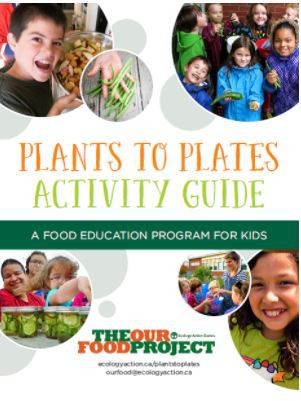 We are very excited to announce that the Plants to Plates Activity Guide is ready, and free to download here. What is Plants to Plates you might ask?
We are very excited to announce that the Plants to Plates Activity Guide is ready, and free to download here. What is Plants to Plates you might ask?
The aim of the Plants to Plates program is to educate kids about how to grow, cook and choose foods. The Plants to Plates program is the result of over five years of program development.

This program takes a “Plants to Plates” (or field to fork) approach, pairing kitchen skill building with garden activities and making connections between how food is grown and how to prepare nutritious, tasty meals. Besides these hand-on skills, we’ve also built an extra layer of learning where every session has a different theme, starting simple, like how to use basic kitchen tools and difference between non-processed and processed foods. To more complex themes like: kid-targeted food branding, the relationship between culture and where we can find food in our communities and who has access to these foods.
I’ve taking the show on the road and sharing this program with people around Nova Scotia and talking to people from across Canada. It’s been encouraging to see people’s interest in teaching kids about food. One question that comes up over and over again is how do we get kids to eat healthy. It seems to be a challenge for many so I’ve I’m including some of my tips here:
How to get the kids to eat the good stuff?
You can’t force anyone to eat food they don’t want to eat. But there are a few things you can try that can help. Here are 4 tips:
1) Start where they’re at. The reality is that many Canadian are eating increasing amounts of highly processed foods, less fruits and vegetable, and less Canadian know how to cook from scratch. It’s important to remember this when choosing your recipes and be strategic. Yes we want to expose kids to new tastes and healthy foods, but ease into it. In your first session maybe don’t choose the 12 grain, no sugar, kale pancakes but pick something kids will be more familiar with, and work your way into more adventurous recipes.
2) Establishing community standards, a set of shared values or Plants to Plates Golden Rules on the first day of your program is very important to having everyone on the same page of what the expectations are for themselves and for others. Involve your group in creating these rules. One rule I like to have is called “no yuky faces”. I explain this as respect different opinions and avoid influencing others’ with comments or by making faces if something is not your favourite.
3) Involving kids in choosing the recipes is a great way to get your group excited about the food you’ll make together. Select appropriate recipes in advance and allow each participant to choose a recipe for one of the sessions.
4) Building time to eat together. Not only is this a great time to talk about what you made and do some informal evaluating, eating together is a nice time to model behaviour. A kid that is tentative in trying something new will be more brave if they’re surrounded by others eating these things.
And persistence of course.
We believe in the importance of teaching kids about food and we hope this guide will make it easier for people like you to do so! Any thoughts or questions on the Plants to Plates program, please get in touch! Georgia@ecologyaction.ca












